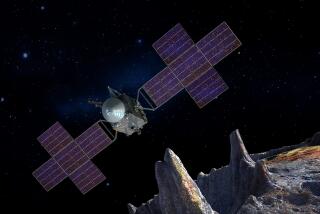Deep Space Probe to Test Host of New Technologies
- Share via
As Pathfinder scientists this week continue to rove the rock gardens of Mars by remote control, the JPL engineers who put together that successful mission are assembling a probe set to leave Earth for deep space next summer--a showcase for a dozen new technologies, including the first flight test of an unusual propulsion system never tried outside the pages of science fiction.
The engineers of the $139-million Deep Space 1 mission showed off their handiwork Wednesday: a compact canister of circuit boards, antennae, imaging devices and fuel tanks quickly taking shape in the cavernous eight-story clean room at the Jet Propulsion Laboratory in Pasadena.
As the first of NASA’s New Millennium missions, the DS1 probe is designed to lay the technological foundations for the next generation of space exploration missions, JPL engineers said. It offers new techniques for powering probes between the planets, communicating with Earth, photographing the sights of space and navigating without human assistance.
“These new missions will require new technologies that have not been tried yet,” said chief mission engineer Marc Rayman. “No one wants to be first, because no wants to take the risk. The New Millennium program is stepping up to take the risk so that no one else has to.”
The DS1 space probe is scheduled to be launched in July from the Kennedy Space Center in Florida for a two-year tour of the solar system’s suburbs, scooting past an asteroid named McAuliffe in January 1999, dipping near Mars in April 2000 and then flying past the Comet West-Kohoutek-Ikemura the following June.
With one probe active on Mars and a second en route, the DS1 craft is the latest sign of the renewed vigor of the U.S. unmanned space exploration program, NASA officials said.
At least four other New Millennium missions are in the planning stages, all intended to push the technology of space flight into the next century.
Perhaps the riskiest--and most promising--new technology is the ion propulsion system that will gently push the DS1 probe up to speeds well beyond anything a conventional chemical rocket can achieve.
Riding on streams of charged xenon ions 10 times faster than the burning gases of chemical rockets, the probe can operate on less fuel with greater thrust and for longer periods than other spacecraft.
“The ion propulsion unit is certainly the flagship technology,” Rayman said. “It allows fast and flexible access to the solar system.” Although the engine’s initial thrust is slow, it steadily builds speed. “Ultimately it will travel much more quickly.”
In its assembly bay Wednesday, the spacecraft under construction was surrounded by technicians in white caps and gowns, festooned with butterflies of red warning tape and draped with snakes of yellow and black caution ribbon. Stripped of its wings of solar panels and linked to diagnostic probes and racks of power buses, it looked like a vacuum cleaner in intensive care.
Despite its unprepossessing appearance, the spacecraft is based on technology so new that “the ink is still wet on the engineering drawings,” one spacecraft worker boasted.
The basic components of the probe arrived at JPL at the beginning of August, and the craft must be ready for its flight tests by late October. It is scheduled to be shipped to the launch site in April, where it will be mated to the Delta rocket that will lift it clear of Earth in July.
To keep up with the new pace of spaceflight while staying within smaller budgets, JPL engineers are working more quickly and with smaller crews, said spacecraft manager Leslie Livesay. While the engineers look to cut corners to save time and money, “what we don’t like to skimp on is tests,” Livesay said. Before it leaves JPL, the craft will have completed 2,000 hours of operational tests, she said.
*
While DS1 takes shape at JPL, the Pathfinder probe still is operating in high gear after 53 days on the surface of Mars, mission scientists said Wednesday. And the Mars Global Surveyor spacecraft--which follows Pathfinder to Mars--recently made its final course correction for its planned Sept. 11 rendezvous with the Red Planet.
Pathfinder scientists said Wednesday that the probe and its robot Sojourner rover have transmitted another 600 megabits of data in the last two weeks, including arresting images of blue sunsets and slivers of high-altitude clouds, and records of swirling dust devils.
The rover has now found two distinct types of rocks on Mars, one Earthlike and full of silicon, the other oddly high in sulfur, said University of Chicago spectrometer expert Tom Economu.
In the coming weeks, Pathfinder scientists expect Sojourner to leave the so-called rock garden and start more distant explorations of the area around the probe.
So far, the six-wheeled rover has traveled 262 feet across the martian surface and covered another 132 feet while turning in place, said Howard Eisen, head of the rover soil mechanics experiment.






